
Original Link: https://www.anandtech.com/show/657
VideoLogic DigiTheatre LC 5.1 Speaker System
by Jim Warren on November 16, 2000 12:00 PM EST- Posted in
- Smartphones
- Mobile
Introduction
As increased processing power brought the ability to playback DVDs to computers, it has also brought affordable surround sound capabilities to accompany the movie experience. At least three sound cards offer the option of outputting the individual channels off of a surround encoded track by incorporating a six channel design, as ABIT revealed their AU10 card to join the market with the Turtle Beach Santa Cruz, and Creative has just recently announced the SoundBlaster Live! 5.1. In addition, more companies are bringing 6 channel cards to the market, as Hercules will have their Gamer XP-2 available at the end of this month.
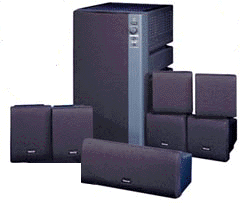 Speaker
designers have taken advantage of this new feature by being able to lower costs
on speaker systems by eliminating the surround decoders previously needed for
a 5.1 surround sound solution, shifting the task to the computer and soundcard.
Six channels of analog audio can now be pulled off a sound card and directly
amplified for a full surround sound listening environment.
Speaker
designers have taken advantage of this new feature by being able to lower costs
on speaker systems by eliminating the surround decoders previously needed for
a 5.1 surround sound solution, shifting the task to the computer and soundcard.
Six channels of analog audio can now be pulled off a sound card and directly
amplified for a full surround sound listening environment.
VideoLogic built upon their earlier success with the Sirocco Crossfire series as it expanded into the 5.1 surround market. Initially, they offered the DigiTheatre system, which included an external Dolby Digital decoder. The system used the digital audio stream via an SPDIF connection to the decoder, which then broke the data down into the 6 analog channels for playback. With the introduction of six channel soundcards, the company has been able to eliminate the decoder from the package and release it as the DigiTheatre LC system for use in conjunction with a six channel audio card.
The announcement of this system shortly followed the premiere of their 6 channel audio card, the VideoLogic Sonic Fury. This card marks a cross distribution agreement between Voyetra Turtle Beach and VideoLogic designed to bring each of their products to both sides of the Atlantic Ocean. The Sonic Fury is identical to the Turtle Beach Santa Cruz sound card, simply distributed in Europe with a slightly different software package. Turtle Beach is also distributing select speaker systems in the United States for VideoLogic.
For American customers, Turtle Beach offers this system through their website for $149.95. This does not include a six channel card or DVD playback software with the required multichannel support. For evaluation purposes, the six channel card used was the Turtle Beach Santa Cruz, and an OEM multichannel version of WinDVD (v 2.2). Until just recently, the multichannel WinDVD was available only through third party OEM manufacturers that provided the software specifically for their multichannel systems. It has just become commercially available through InterVideo's website for users needing the software.
Specifications
The DigiTheatre LC system consists of a subwoofer enclosure that includes the six channel amplifier for the system, a center satellite, two front satellites, and two rear satellites. The cabinets are all made of plastic, including the subwoofer enclosure, this reduces weight and cost, but doesn't show the same commitment to quality as wooden speakers enclosures might have. Here's what VideoLogic tells us about their system:
|
Specifications (Courtesy of VideoLogic) |
|
|
RMS
Power
|
Total:
62.5W RMS
Satellites: 7.5W + 7.5W (0.04% THD) Center: 7.5W (0.05% THD) Subwoofer: 25W (0.038% THD) |
|
Frequency
Response
|
Satellites:
180Hz - 20kHz
Center: 140 Hz - 20 kHz Subwoofer: 50Hz - 200Hz |
|
Input
Sensitivity
|
DVD
input: 250 mV
Line inputs: 500 mV |
|
Drivers
|
Front:
4 inch midrange shielded / 2 inch Neodynium tweeter
Surround: 4 inch Center: 3 inch magnetically shielded Subwoofer: 6.5 inch magnetically shielded |
|
S/N
Ratio
|
Satellites:
70dB
Center: 67dB Subwoofer: 69dB |
|
Function
Controls
|
Power/volume,
input select, LED display
|
|
Dimensions
(WxHxD)
|
Front:
114 mm (W) x 236 mm (H) x 150 mm (D)
Surround: 114 mm (W) x 151 mm (H) x 150 mm (D) Center: 260 mm (W) x 106 mm (H) x 155 mm (D) Subwoofer: 228 mm (W) x 406 mm (H) x 325 mm (D) |
Setup
The nature of this review is to examine solely the speakers, though a moment should be dedicated to the card used for review. In a computer based decoding situation, now becoming more prevalent as six channel audio cards provide an economical alternative to an external decoder, the sound card plays a role in the speaker performance.
The Turtle Beach Santa Cruz card used for the review system provided a basis for the six channel concept VideoLogic used to design the system, as it is the same card they distribute under their name in Europe for use with the product. VideoLogic also offers the option of bundling the card with the speakers under the name DigiTheatre PC for European distribution, and includes the necessary multichannel DVD software to access the six outputs.
However, in the States, the assembly of this package is left to the user. When we intitiated our evaluation, the full system was not readily commercially available; the six channel card and speakers were on the market, but getting the WinDVD software that took advantage of all six outputs proved to be difficult. Finally, an OEM version was acquired that enabled the system to work. Now, the software has been made commercially available, though the system still has to be "assembled" from multiple suppliers.
The speakers were also tested using the Windows 98 platform; the six channel capabilities for the Santa Cruz are currently unavailable under Windows 2000. Most speaker systems are fairly platform independent, though now that the decoders are being integrated into soundcards, these compatibility issues arise. Once the card was configured and working, it was time to setup the speakers.
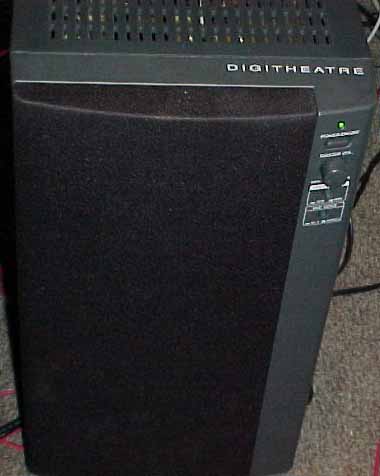
Opening the box started with pulling out the cables for hooking the system up. Included are three stereo miniplug to RCA adaptors to tap off of the sound card, and 5 speaker wires of varying lengths to connect the speakers to the sub/amplifier enclosure. Though not labeled on the wire, a wire stripper indicates that the speaker wires included are 22 AWG. Though not the heaviest wire, the speakers are handling a relatively low level of power, and the wire could be called sufficient. It would have been nicer to see a stronger commitment to quality in the cabling. The surround cables are long enough to go across a decent sized room, though the front speakers are slightly limited in their reach. The other components in the systems are simply the two front speakers, two rear surrounds, the center channel speaker, and the amplifier/bass unit.
Connections between the speaker system and computer are fairly straightforward. Six RCA connectors are connected to the sound card via the adaptors included. However, after the first setup, the initial listening test indicated that the left and right channels were reversed in the system. After some brief troubleshooting, the adaptors were identified as the source of the problem. They are not wired out of phase, but are instead wired contrary to the left/right convention their color code follows, as confirmed through a continuity check. Luckily, this problem was identified before running frequency response tests, as in a six channel sound card the center channel and LFE channel are output through the same stereo connection, and swapping those frequency specific outputs could damage the speakers.
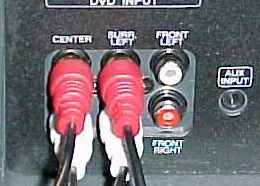
In addition to the surround sound connections, there is an auxiliary connection provided via an eighth inch stereo minijack. There is a coinciding selector switch on the front of the bass unit that switches between the "DVD" input and the aux input. In addition, the front panel also includes selection between AC-3 and Stereo operation, which takes the front stereo channel and just distributes it to the rear surrounds as well. The front panel is finished off with the power switch and master volume control.
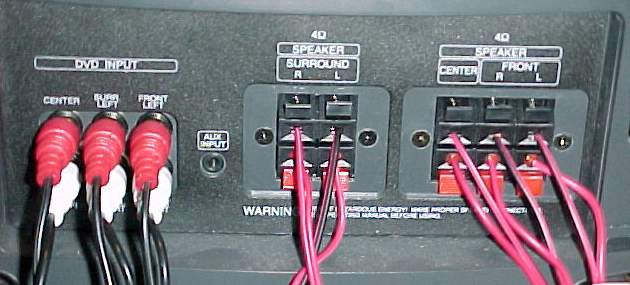
Speaker connections are made using spring terminal connections. The included speaker wires is simply two-conductor wire with tinned ends. The tinning, or addition of solder to the stranded ends, minimizes fraying during connection, as the wire is stranded for flexibility. The push terminals also offer the option of replacing or adding speaker wire of different length or quality.
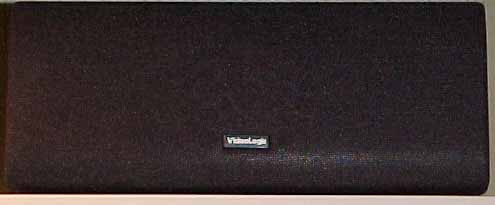 |
Once the speakers are all connected, all that remains is placement. The system does not include any stands for either the front or rear surrounds; these can be order from VideoLogic as accessories, though none of the options include floor stands for rear surrounds. The front speakers have a top speaker and bottom speaker that can swivel on each other, increasing the dispersion of the front channels. However, these simply misalign the tweeter and woofer, which is not ideal for the truest sound. At least the spread is not predetermined, and can be set for a single user in a nearfield listening environment by aligning the drivers.
 |
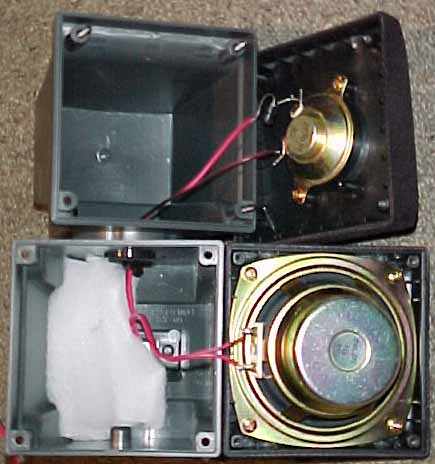 |
The rear surrounds need to be placed behind the listening position on ear level with the user, so they can be somewhat awkward in a larger room, though are worth it for the listening experience.
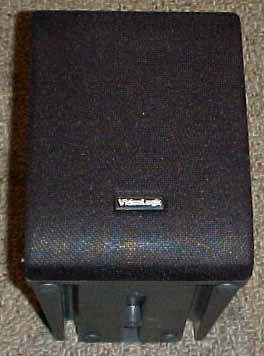
Once the speakers were setup, it was time to sit back and see how they performed. Through a series of tests, we developed our opinion of what they have to offer.
The Sound
Sitting back and listening to this system can only be described as a pleasure. The first listening test is generally a well known piece of music at a moderate volume level. This gives a first impression of the system-the song will either sound normal, really nice, or it will be missing something that really sticks out. The DigiTheatre system elicited surprise with the first notes. Simply put, the sound was smooth with presence in the upper mid range that is enough to sit up and pay attention to. But let us break down what the speakers can do.
Looking at the specifications, there is some indication that the speakers could be strong candidates. The signal to noise ratio is decent, if not of the highest quality, while the THD specs indicate that the amp can handle pushing the speakers without changing its tonal quality significantly. A 70 dB S/N ration indicates that the system will have some noise, or hiss, at higher volumes, but that it should not overwhelm program nuances except in situations with a large dynamic range. For a more in depth explanation of what the specifics behind the specifications are, check out the Speaker Buying Guide.
Running frequency sweeps through the individual channels reveal that they have a fairly consistent response. In addition to the LFE information encoded in the ".1" channel of Dolby Digital, the lowest frequencies of the front channels are processed through a crossover and the low pass information is sent to the sub channel as well. This extends the frequency response for stereo reproduction, as the sub is better suited to handle the longer wavelengths than the smaller satellites are.
For surround sound listening, the system is well suited to watching a movie at the normal computing area, or even spreading out a bit onto a couch with a couple of friends. The system will not shake the room, but it can carry its surround capabilities to more than one listener, while preserving its tonal quality. The center channel does a strong job of reinforcing the vocals, and distinctly localizes them to the picture even when the stereo fronts are close in to the monitor. This builds the reality of a movie by enhancing the eye to ear correlation for speaking parts. Yes, that is the whole point of surround sound, but this system gets it right, and makes for an enjoyable experience.
The only argument with the system falls with its bass
response. For watching a DVD, it seems to fall a little short on the low end.
The midrange is strong and consistent, with a crisp high end that maintains
the listeners' attention, though some of the lower frequencies begin to get
lost in the mix. Even the plastic construction does not hold back the satellite
speakers; no perturbing resonant frequencies caused trouble during the tests.
Though the construction could be part of what is holding the bass back, as it
represents that the construction, and therefore strength, of the system was
compromised on. The lower frequencies suffered as a result. When tweaked with
software equalization, the amplification is not very consistent and the sub
wants to distort instead of accurately reproducing loud bass. The bass quality
was not consistent with the over all quality of the system.
Not everything in life is encoded for Dolby Digital, much to the disappointment
of some. Even with the best surround sound system, it is still important to
see how their stereo playback functionality is. The acoustics of the system
continue in the situation, with a very pleasing tonal quality. Once again, the
bass falls short of expectations. Though clarity and quality are both present
in the stereo reproduction.
At moderate to loud volumes, the sound quality of the system holds up well. It can easily play to a small number of listeners, or just a single user, with equal quality standards at moderate listening levels. When the system is cranked up, the drivers begin to clip, which is immediately noticed in degraded program quality. The system isn't designed for a rock concert or rave-there is a sense of scale necessary in using it. It will not blow anybody out of their chair, but will give them plenty of reasons to stay there at a moderate volume.
As the volume rises in the system, it maintains its clarity to a point. Then, the lower midrange begins to get muddy, and distortion occurs there as the SPL continues to rise. As the bass goes up, the sub will also distort rather noticeably. This isn't a system for high impact gaming or intense action movies, though people that enjoy really listening to their sound will appreciate what they can do while not trying to blow out anyone's eardrums.
Conclusion
VideoLogic's DigiTheatre LC system provides yet another option for bringing surround sound to the computer. Designed as an economical solution, its price of $149.95 doesn't tell the whole story. To get it working in all of its 5.1 glory, a six channel card is necessary (one option is the Turtle Beach Santa Cruz at $99.95), and six channel DVD software (one option is the multichannel version of WinDVD 2.2 at $49.95) are necessary. In essence, the economy applies more to the manufacturer than to the consumer, as the package price to achieve full functionality approaches $300. That's the money behind the speakers, regardless of their street price, as they build on new technology that is unlikely to be in many computers already out there.
Beyond the issues of its true "economy", the system is a pleasure to listen to. For a broad range of music tastes, from classical to classic rock, it has place in a critical listening situation. The tonal quality is very strong in the satellite speakers, and for anyone that isn't expecting pounding bass, the speakers would be extremely well suited. The lack of bass response holds them back; even a bass adjustment knob is lacking, and only tonal adjustments can be made through software.
The system seems to be extremely minimalistic. The only accessories included are cables, which were satisfactory, though nothing to gush over. It is worth checking the included adaptors to insure that the correct connections are made. In addition, the lack of stands for the rear surround speakers is another accessory that will add to the overall package price; without a good stand, it is difficult to get the optimum placement.
The strength of this system is in how the satellites sound, in both stereo and surround sound mode. Its weakness is definitely the heavy hitting parts of the system-the bass and the system volume. It will not shake or blow anyone out of the room with sheer power without clipping the speakers. For that experience, look to a higher powered system, but stick with these for a quality listening experience.







